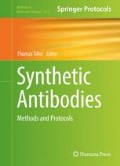Abstract
We describe a mass spectrometry-based approach for validation of antibody specificity. This method allows validation of antibodies or antibody fragments, against their endogenous targets. It can assess if the antibody is able to bind to its native antigen in cell lysates among thousands of other proteins, DNA, RNA, and other cellular components. In addition, it identifies other proteins the antibody is able to immunoprecipitate allowing for the assessment of antibody specificity and selectivity. This method is easily scalable, adaptable to different cell lines and conditions and has been shown to be reproducible between multiple laboratories.
Access this chapter
Tax calculation will be finalised at checkout
Purchases are for personal use only
References
Marcon E, Jain H, Bhattacharya A, Guo H, Phanse S, Pu S et al (2015) Assessment of a method to characterize antibody selectivity and specificity for use in immunoprecipitation. Nat Methods 12:725–731
Shannon P, Markiel A, Ozier O, Baliga NS, Wang JT, Ramage D et al (2003) Cytoscape: a software environment for integrated models of biomolecular interaction networks. Genome Res 13:2498–2504
Marcon E, Ni Z, Pu S, Turinsky AL, Trimble SS, Olsen JB et al (2014) Human-chromatin-related protein interactions identify a demethylase complex required for chromosome segregation. Cell Rep 8:297–310
Guruharsha KG, Rual JF, Zhai B, Mintseris J, Vaidya P, Vaidya N et al (2011) A protein complex network of Drosophila melanogaster. Cell 147:690–703
Cox J, Mann M (2008) MaxQuant enables high peptide identification rates, individualized p.p.b.-range mass accuracies and proteome-wide protein quantification. Nat Biotechnol 26:1367–1372
Zybailov BL, Florens L, Washburn MP (2007) Quantitative shotgun proteomics using a protease with broad specificity and normalized spectral abundance factors. Mol Biosyst 3:354–360
Mellacheruvu D, Wright Z, Couzens AL, Lambert JP, St-Denis NA, Li T et al (2013) The CRAPome: a contaminant repository for affinity purification-mass spectrometry data. Nat Methods 10:730–736
Dou Y, Milne TA, Ruthenburg AJ, Lee S, Lee JW, Verdine GL et al (2006) Regulation of MLL1 H3K4 methyltransferase activity by its core components. Nat Struct Mol Biol 13:713–719
Thomas P, Smart TG (2005) HEK293 cell line: a vehicle for the expression of recombinant proteins. J Pharmacol Toxicol Methods 51:187–200
Acknowledgments
The Structural Genomics Consortium (SGC) is a registered charity (number 1097737) that receives funds from AbbVie, Bayer Pharma AG, Boehringer Ingelheim, Canada Foundation for Innovation, Eshelman Institute for Innovation, Genome Canada, Innovative Medicines Initiative (EU/EFPIA) [ULTRA-DD grant no. 115766], Janssen, Merck & Co., Novartis Pharma AG, Ontario Ministry of Economic Development and Innovation, Pfizer, São Paulo Research Foundation-FAPESP, Takeda, and the Wellcome Trust. We also gratefully acknowledge Leif Dahllund for assistance with cell culture work and Elena Ossipova for sample preparation before MS.
Author information
Authors and Affiliations
Corresponding author
Editor information
Editors and Affiliations
Rights and permissions
Copyright information
© 2017 Springer Science+Business Media LLC
About this protocol
Cite this protocol
Persson, H., Preger, C., Marcon, E., Lengqvist, J., Gräslund, S. (2017). Antibody Validation by Immunoprecipitation Followed by Mass Spectrometry Analysis. In: Tiller, T. (eds) Synthetic Antibodies. Methods in Molecular Biology, vol 1575. Humana Press, New York, NY. https://doi.org/10.1007/978-1-4939-6857-2_10
Download citation
DOI: https://doi.org/10.1007/978-1-4939-6857-2_10
Published:
Publisher Name: Humana Press, New York, NY
Print ISBN: 978-1-4939-6855-8
Online ISBN: 978-1-4939-6857-2
eBook Packages: Springer Protocols

